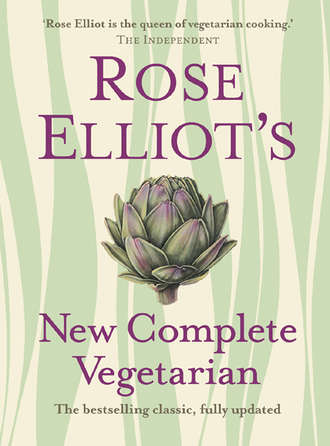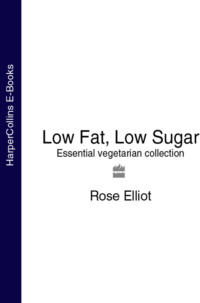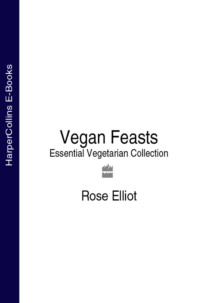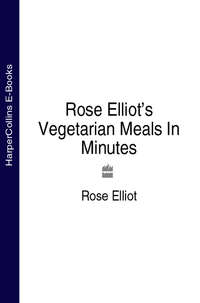
Полная версия
Rose Elliot’s New Complete Vegetarian


ROSE
ELLIOT’S
New Complete
Vegetarian

Copyright
HarperCollinsPublishers 1 London Bridge Street London SE1 9GF
www.harpercollins.co.uk
First published in 2010 by Collins
Some of the recipes in this book first appeared in Fontana paperback and in Rose Elliot’s Complete Vegetarian Cookbook.
Text © Rose Elliot, 1985 and 2010 Photographs © Kate Whitaker, 2010 Vana Haggerty and Ken Lewis
Commissioning editor: Lizzy Gray
Photography: Kate Whitaker
Food and prop styling: Joss Herd and Penny Markham
Rose Elliot asserts her moral right to be identified as the author of this work.
All rights reserved under International and Pan-American Copyright Conventions. By payment of the required fees, you have been granted the non-exclusive, nontransferable right to access and read the text of this e-book on-screen. No part of this text may be reproduced, transmitted, down-loaded, decompiled, reverse engineered, or stored in or introduced into any information storage and retrieval system, in any form or by any means, whether electronic or mechanical, now known or hereinafter invented, without the express written permission of HarperCollins ebooks.
HarperCollinsPublishers has made every reasonable effort to ensure that any picture content and written content in this ebook has been included or removed in accordance with the contractual and technological constraints in operation at the time of publication.
Source ISBN: 9780007325610
Ebook Edition © MARCH 2012 ISBN: 9780007372003
Version: 2016-03-21
Contents
Cover
Title Page
Copyright
Cook’s notes
Introduction
Soups
First courses, snacks and drinks
Sauces and relishes
Salads and salad dressings
Side dishes
Vegetables and nuts
Pulses
Pasta
Grains and rice
Flans and pies
Cheese and eggs
Puddings
Baking
Bread and yeast cookery
Keep Reading
Acknowledgements
About the Author
About the Publisher
Cook’s notes
IMPORTANT NOTE ABOUT OVEN TEMPERATURES Ovens need to be preheated to the specified temperature. All the temperatures in this book are based on a conventional oven. If you’re using a fan-assisted oven, follow the manufacturer’s instructions for adjusting the temperature – this usually means reducing it by 20°C (65°F), gas mark 1.
Butter The type of butter is specified only where it is critical, otherwise use salted or unsalted.
Cheese More and more cheeses are vegetarian, but there are some important ones that are not as they contain rennet (an animal product). When buying cheese always check that it’s vegetarian or choose a vegetarian alternative – try pecorino instead of Parmesan, Emmental instead of Gruyère, Danish Blue (or other blue cheeses marked ‘vegetarian’) instead of Roquefort.
Eggs They are medium size unless specified otherwise. I always use free-range organic eggs. Pregnant women, the elderly or frail, and very young children need to avoid eating recipes containing raw eggs.
Stock powder, cubes and concentrate There are some good ones available. Check the label and choose one containing natural ingredients.
Soy sauce Choose the most natural type you can find; traditionally brewed, without additives such as colouring or caramel. Dark Kikkoman (with the red top) is a reliable brand that’s widely available but try shoyu and wheat-free tamari; both are available from large supermarkets and health shops.
Wine and fortified wine As with cheese, wine is often not vegetarian or vegan so check the label (or ask the wine merchant for advice) when buying. When choosing sherry, pick the ‘fino’ variety, as this is vegetarian, and with port, buy the ‘crusted’ variety, named because of the sediment or ‘crust’ that forms in the bottle.
The Vegetarian Society, the Vegan Society and VIVA! (Vegetarian International Voice for Animals) are all excellent sources for information on products and ethical issues.
www.roseelliot.com

Introduction
When I wrote my Complete Vegetarian Cookbook, back in 1985, vegetarian and vegan food was not as popular or as mainstream as it is today. Nowadays, I look around my local supermarket and there is a wealth of fabulous fresh produce available. I can enjoy ingredients from around the world and if I am cooking for someone with a dietary requirement, there are loads of alternatives to pick from. In fact, following a healthy, nutritious and varied diet has never been easier. So, I hope my New Complete Vegetarian recipe book will help you make the most of the glorious range of ingredients we can all enjoy.
In this book you’ll find hundreds of delicious, easy-to-make vegetarian and vegan recipes. Here you’ll find my classic recipes that I turn to again and again, and often get asked for, plus many new ones to enjoy. You’ll also find information on cooking and preparing vegetables, fruits, pulses and nuts, plus symbols for those recipes that are vegan v and those that can be frozen

So, if you’re one of my dear loyal readers from the past, I hope you will love this new edition as much as you did the first one; and if this is your first encounter with my Complete Vegetarian Cookbook, it’s so good to have you here and I hope you will find it an inspiring and practical friend in the kitchen. Whether you’re an old friend or a new one, I wish you many wonderful meals and health and happiness in your life and on your vegetarian journey.
Soups

Soup is one of the most satisfying things to make and eat, and it’s so varied and adaptable. It can be hot or chilled, smooth or chunky, thick or delicately light. Truly, there is a soup for all tastes and seasons.
In this chapter you’ll find a mouth-watering variety of soups, from broths such as miso soup to thick and chunky soups like lentil with garlic and cumin. There are plenty of quick-to-make soups, plus elegant ones for entertaining. You’ll also find a recipe for vegetarian stock. While using your own stock can give a beautiful flavour, it’s also fine to use bouillon powder, concentrate or cubes. You can also get excellent results using just water; I often do this when I want the pure taste of a particular vegetable to really sing through.
Many homemade soups freeze excellently, and you’ll find the freezer symbol

Easy vegetable stock v
Although you can now buy very acceptable vegetarian stock powder, which I often use for speed, nothing beats a good home-made stock. It’s easy to make – 10 minutes of simple preparation followed by an hour of slow simmering and you’re done. It keeps perfectly for a week in the fridge or for 3–6 months in the freezer. This is a good basic stock but you can also jazz it up by adding a few cloves of garlic, some peppercorns and any other herbs you fancy, such as bay leaves or thyme.
MAKES ABOUT 1.2 LITRES (2 PINTS)

1 onion, roughly sliced
1 stick of celery, roughly chopped
1 large carrot, roughly chopped
1 potato, roughly chopped
a few sprigs of parsley
2.5 litres (4 pints) water
Put the vegetables and parsley into a large saucepan and add the water.
Bring to the boil, then turn the heat down, cover and leave to simmer for 40 minutes.
Strain through a sieve. Cool, then keep in the fridge or freeze in suitable-sized containers.
Tip
Toss the vegetables in 1–2 tablespoons of olive oil and roast for 20–30 minutes at 200°C (400°F) gas mark 6, before proceeding as above, for a fuller flavour.
Artichoke soup
Smooth and creamy, this slips down your throat like velvet. Jerusalem artichokes are quite easy to peel if you use a potato peeler and are fairly ruthless about cutting off the little lumps. Put them into a bowl of cold water as they’re done, to preserve their colour.
SERVES 6

25g (1oz) butter
1 onion, chopped
900g (2lb) Jerusalem artichokes, peeled and cut into even-sized chunks
1.2 litres (2 pints) light vegetable stock or water
150ml (5fl oz) single cream (optional)
275ml (10fl oz) milk
sea salt
freshly ground black pepper
freshly grated nutmeg
2 tbsp chopped fresh chives or flat-leaf parsley, to garnish
Melt the butter in a large saucepan and add the onion. Cover the pan and fry gently for 5–7 minutes or until fairly soft but not browned, then add the artichokes, cover the pan again and cook for a further 2–3 minutes, stirring often.
Pour in the stock or water, bring to the boil, then turn the heat down, cover and leave to simmer for about 20 minutes or until the artichokes are soft.
Blend the soup very well, and pass it through a sieve if you want it really smooth, then add the cream if you’re using it, and enough milk to make the soup the consistency you like.
Season to taste with salt, pepper and freshly grated nutmeg. Reheat, and serve with some chopped chives or parsley sprinkled on top.
VARIATION
Artichoke soup with truffle oil
Truffle oil adds a deep, earthy flavour to this beautiful soup. Make as described and season with salt and pepper, but omitting the nutmeg and herbs. Pour into warm bowls and swirl each with a good teaspoon of truffle oil.
Asparagus soup
One of my favourite summer soups, this makes a wonderful starter for a special occasion and can also be served chilled in hot weather.
SERVES 4

1 onion, chopped
1 potato (about 50z (150g)), peeled and cubed
1 tbsp olive oil
500g (1lb 2oz) asparagus, washed
about 1 litre (1¾ pints) water
1 tsp vegetable bouillon powder or a stock cube
4 tbsp single cream
salt and freshly ground black pepper
In a large covered saucepan, fry the onion and potato cubes in the olive oil over a gentle heat. Fry for a few minutes, stirring now and again.
Break the tips off the asparagus stems by bending them until they snap. Place the tips to one side. Cut the stems into 2cm (1 in) pieces and add to the pan, along with half the water and the vegetable bouillon. Bring to the boil, then leave to simmer gently for about 30 minutes, until the asparagus is tender.
Meanwhile, heat the remaining water in another pan and cook the asparagus tips until tender, about 7 minutes. Drain, reserving the cooking water.
Purée the soup thoroughly and, for an extra-smooth texture, pour it through a sieve, back into the rinsed-out saucepan. Add the cooked asparagus tips together with their cooking water and the cream. Season well with salt and pepper.
Reheat gently before serving; don’t let it boil.
Chilled avocado soup
This beautiful pale green, silky soup is very easy to make. Use avocados that are perfectly ripe but not overly so; they’re just right when they feel slightly soft all over when you squeeze them gently in the palm of your hand. Avoid making this soup in advance; it just needs time to chill in the fridge so that it keeps its bright colour.
SERVES 6
2 large ripe avocados
1 tbsp lemon juice
850ml (1½ pints) ice-cold skimmed milk
salt and freshly ground black pepper
2 tbsp chopped fresh chives, to garnish
Halve, stone and peel the avocados and cut them into rough chunks.
Put the chunks into a blender or food processor with the lemon juice and milk and blend very thoroughly until the mixture is silky smooth.
Taste and season well with salt and pepper. Chill in the fridge, with the serving bowls too, if there’s room.
To serve, check the seasoning, as chilling can dull the flavour, then ladle the soup into the bowls and scatter some bright green chopped chives on top.
Beetroot soup
One of my all-time favourite soups, this is a stunning deep ruby-red soup that looks mouth-watering with its white topping of yoghurt or soured cream. It’s wonderful hot, but I particularly like to make it from new-season beetroot in the summer and serve it chilled. I think you’ll have gathered by now that I’m rather partial to chilled soup!
SERVES 4

1 onion, chopped
1 tbsp olive oil
1 large potato (about 225g (8oz)) peeled and diced
1 tbsp olive oil
450g (1lb) cooked fresh beetroot (not in vinegar), peeled and diced
1.2 litres (2 pints) stock or water
1 tsp vegetable bouillon powder, stock cube or concentrate
salt and freshly ground black pepper
1 tbsp lemon juice
½ tsp grated lemon rind
TO GARNISH
thick natural Greek yoghurt, soured cream or crème fraîche
coarsely ground black pepper
Fry the onion gently in the oil in a fairly large saucepan, with a lid on the pan, for about 5 minutes, being careful not to let it brown. Add the potato, stir, then cover and cook gently for about 5 minutes more.
Add the beetroot and stir in the stock or water and the bouillon powder, stock cube or concentrate.
Bring to the boil then cover and leave to simmer for about 20 minutes or until the potatoes are soft.
Blend the soup, then return it to the saucepan and flavour with salt, pepper and the lemon juice and just a touch of the grated rind. Reheat gently and serve topped with a spoonful of yoghurt, soured cream or crème fraîche and a scattering of coarsely ground black pepper.
Borsch
You could serve this soup with the little curd cheese tarts on page 272 but it’s also great accompanied by chunks of rye or wholemeal bread and goat’s cheese.
SERVES 4

2 tbsp olive oil
2 large onions, chopped
2 large carrots, diced
2 sticks of celery, sliced
125g (4oz) cabbage, chopped
2 tbsp olive oil
1 litre (1¾ pints) water or vegetable stock
400g can chopped tomatoes
450g (1lb) cooked beetroot (not in vinegar), peeled and diced
salt and freshly ground black pepper
sugar
TO GARNISH
150ml (5fl oz) soured cream or thick natural yoghurt (optional)
chopped fresh dill or chives (optional)
Heat the oil in a large saucepan, add the onions, carrots, celery and cabbage, stir them in the oil so they glisten, then fry over a gentle heat for about 10 minutes, with the occasional stir.
Pour in the water or vegetable stock and the tomatoes, bring to the boil, cover and leave to simmer for about 20 minutes or until all the vegetables are tender.
Add the beetroot to the soup and season well with salt, pepper and a little sugar. Bring to the boil again and simmer gently for 3–4 minutes.
Serve the borsch as it is or blend it a little. If you like, top with soured cream or yoghurt and a scattering of chopped dill or chives.
Creamy butter bean soup with croûtons
This soup has a smooth, creamy texture that is complemented perfectly by its crunchy topping of golden-brown croûtons.
SERVES 4

125g (4oz) dried butter beans, soaked
2 tbsp olive oil
1 large onion, chopped
1 potato, peeled and diced
2 carrots, diced
2 sticks of celery, chopped
1.2ml (2 pints) water or unsalted stock
1 bouquet garni – a couple of sprigs of parsley, a sprig of thyme and a bay leaf tied together
150ml (5fl oz) single cream (optional)
salt and freshly ground black pepper
freshly grated nutmeg
a few croûtons or cubes of crispy wholemeal toast, to serve
Drain and rinse the beans.
Heat the oil in a large saucepan, add the vegetables and sauté for 7–8 minutes without browning, then add the butter beans, water or stock and the bouquet garni. Simmer gently, half covered, for about 1½ hours or until the butter beans are tender.
Remove the herbs and blend the soup (with the cream, if using). Season well with salt, pepper and nutmeg to taste.
Reheat gently – don’t let the soup boil – and scatter over the crunchy golden croûtons or crisp wholemeal toast cubes at the last moment.
Butter bean and tomato soup v
I love to use dried butter beans for this, though I’ve given the option of canned, as dried beans are such a joy. You can buy them for practically nothing, keep them in the cupboard until you need them, then work some kitchen alchemy just by gently soaking and boiling, to produce a meal that’s deeply satisfying and full of natural goodness. If you are cooking your own beans, use the cooking water for this soup, with some vegetable bouillon powder for extra flavour.
SERVES 4

2 tbsp olive oil
2 large onions, chopped
225g (8oz) dried butter beans, soaked, cooked until tender and drained, or 2 x 400g can butter beans, drained and rinsed
850ml (15 pints) water or unsalted vegetable stock
1 bay leaf
2 x 400g cans chopped tomatoes
salt and freshly ground black pepper
sugar (optional)
chopped fresh flat-leaf parsley, to garnish
Heat the olive oil in a large pan, add the onions and fry over a gentle heat for about 10 minutes, until softened, but not browned.
Add the cooked butter beans, water or stock, bay leaf and tomatoes. Bring to the boil and simmer gently for 10–15 minutes.
Taste and season with salt, pepper and a little sugar if you think it needs it.
Blend a bit with a hand blender or leave the soup as it is. Serve sprinkled with the parsley.
Roasted butternut squash soup with chilli oil v
This is so easy to make – it’s pretty much a case of ‘roast and whiz‘. The butternut squash is cooked in the oven while you leisurely fry an onion and some garlic, then all you have to do is purée it with some vegetable stock, and there’s your beautiful golden soup.
SERVES 4-6

1 butternut squash
2 tbsp olive oil, plus extra for brushing
1 onion, chopped
1 large garlic clove, crushed
about 1.5 litres (2½ pints) vegetable stock
salt and freshly ground black pepper
4–6 tsp chilli oil, to serve
Set the oven to 190°C (375°F), gas mark 5.
Cut the butternut squash in half lengthwise. You might find it easier to cut it in half widthways, then cut each of these pieces in half. It doesn’t really matter how you do it, and there’s no need to remove the seeds at this point.
Put the pieces of squash in a roasting tin, brush the cut surfaces with oil and bake for about I hour, or until the squash is soft.
While the squash is roasting, heat the olive oil in a saucepan over a gentle heat, add the onion, cover and cook gently for about 8 minutes. Add the garlic and cook for a further 2 minutes.
Scoop out the flesh of the butternut squash, discarding the seeds. Pull off and discard the skin – it will come away easily. Purée the flesh and their juices, along with the onion and garlic.
Put the purée into a pan and stir in enough vegetable stock to make a consistency that’s pleasing to you. Season to taste with salt and pepper. Gently heat through, then serve with a swirl of chilli oil on top of each bowl.
VARIATION
Roasted butternut squash with goat’s cheese toasts
Make the soup as described. While it’s heating through, make the goat’s cheese toasts. Allow half a large slice of bread per serving. Toast the bread then top the toast with mashed soft-rind goat’s cheese and brown under a hot grill. Cut each piece into small squares and put these on top of the soup just before serving.
Carrot and thyme soup v
This is a light and refreshing soup that’s almost fat-free. It’s thin and smooth, so you can sip it from a large mug as you warm your hands and eat a sandwich. If you think you might prefer it a bit thicker, start with less water; you can always add more. I like this soup so much that I often make double this amount! You really do need high-quality bouillon powder for this, both for the flavour and the extra body that it gives.








